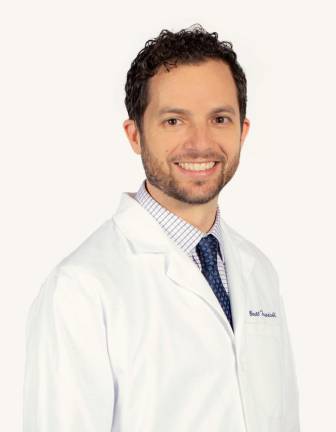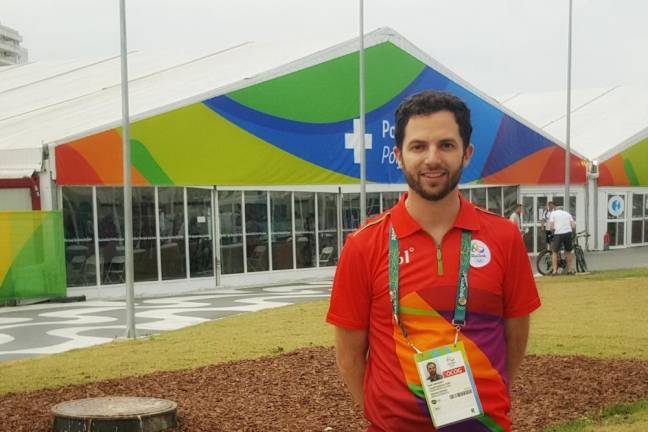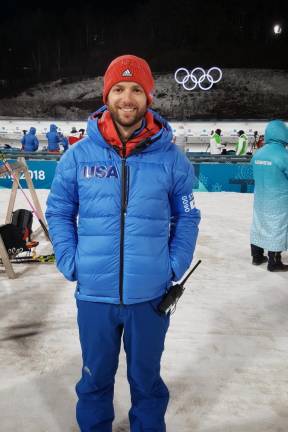Doctor, Runner, Healer
Hospital for Special Surgery’s Dr. Brett Toresdahl, a medical captain at the TCS New York City Marathon, on best practices to avoid injuries



Growing up in Montana, Brett Toresdahl got injured “quite a bit” while mountain biking and snowboarding. Little did he know that those injuries would lead him to his life’s work.
As an assistant attending physician at Hospital for Special Surgery and research director for the HSS Primary Care Sports Medicine Service, he sees patients who range from “a big football player to a petite ballerina.” “I think I have the best job where I get to help people get back into being active and exercising and doing the things that they love to do,” he said. Other rewarding parts of his impressive resume including serving as the team physician for US Biathlon, Rugby United New York and New York Cosmos as well as volunteering in the medical clinic at two Olympic games.
In 2019, the now-Upper West Side resident was a medical captain at the TSS New York City Marathon and is back for his second stint there this year. Having himself run the Marathon in 2018 and hoping to train for another in the near future, he applied the firsthand experience from getting injured during training and realizing the lack of resources for runners to his professional life. This led him on the path to research, and he teamed up with the run tracking app Strava to use the data it collects to provide more customized plans for runners so they can avoid injury.
When talking about the common mistakes made during marathon training, Toresdahl noted that injuries occur when individuals try to get back on track and overcompensate by doing multiple runs and increasing their mileage per week. “Often what people will do is they’ll print out a 16-week training plan. They have their papers on their refrigerator and they’re just checking off runs as they go. But life gets in the way, injuries come up, illnesses happen, so people commonly fall off track.”
When did you know you wanted to go into the medical field and more specifically, when did you decide to focus on sports medicine?
I grew up in Montana and got injured quite a bit, skiing and snowboarding in the mountains. And I ended up having various broken bones from snowboarding and mountain biking so I was exposed to a lot of sports medicine at an early age, which is how most people end up going into sports medicine or orthopedics ... And then I was exposed to what’s called primary care sports medicine, a non-surgical sports medicine specialty, and that’s what I ended up going into. I trained in family medicine, did a sports medicine fellowship, and so now, I see patients a few days a week; I do research a couple of days a week, so I feel very fortunate for this road that I’m on.
Explain what your job as a medical captain at the Marathon entails.
In 2019, I was a medical captain at one of the aid stations along the course. I, along with another co-captain, were overseeing the medical care of the runners who were coming into the tent at that mile marker. The New York City Marathon is so big that it has medical stations at every mile essentially, plus a giant finish-line medical tent. And we were at mile 16 or 18, I believe; it was along First Avenue, so we’d be seeing runners who were starting to cramp up or have other issues but were trying to keep going. A few runners ended up having to drop out because of injuries or exhaustion.
When I was in Seattle, I worked with the Seattle Marathon, the Rock ‘n’ Roll Half Marathon, so had some experience helping out with the race-day medical care. I’m going to do that again this year as a medical captain. A lot of the work that I do with runners is end up treating their injuries as they’re training for marathons, helping them figure out ways to prevent injuries in future attempts to complete a marathon.
Tell us about the research you did with the app Strava involving runners’ injuries.
At the 2019 New York City Marathon we partnered with Strava, a free application that’s really popular among runners to log their training and to have some social interaction with other runners. So we knew that runners were collecting all of this data on their training, but it really wasn’t being used for medical research to try to figure out why runners are getting injured. There are a lot of studies to try to figure out what are the risk factors for running injuries, [but] other than just running a lot and having a prior injury, there’s not a lot of consistent risk factors for injuries.
So we partnered with Strava to allow runners to collect data using their application, and we analyzed it after the fact and we were surveying them along the way to find out which runners were getting injured and what kind of injuries. And then after the race, we analyzed that to find training patterns that were associated with these injuries that they were reporting to us. So then once we learned about that, the next step that we’re working on now and we’re applying for a grant for support, is to use that information to actually provide guidance in real time to the runners. We plug the training data into an algorithm and provide some more customized guidance for runners so hopefully they can increase their training a little bit more consistently or appropriately for what they’ve been able to do over the past few weeks.
When you ran the marathon, when did you start your training?
I had just finished a Brooklyn Half Marathon, that was in May, and so I tried to maintain a bit of that training throughout June. And then really by July, I was starting to get on to the typical 16-week plan. I’m sure I made all the same mistakes that other runners make in terms of thinking, “Oh, I can kind of catch up here.” I broke my toe midway through training, and that set me back, so trying to play catch up and not knowing what to do. It’s a bit of trial and error and there’s really just no great resource out there and that’s what I found. It’s just tough to navigate that, even with some of the clinical experience that I’ve gained over the years. Having some sort of evidence-based algorithm or guidance would be really helpful.
Tell us about your experience working at the Olympics.
I have been to two Olympics as a physician ... When I started at HSS there was a connection between HSS and the organizing committee of the Rio Games. And they reached out to HSS to have some support from physicians and physical therapists and so a small group of us spent a couple of weeks in Rio during the games working at the Polyclinic, which is the clinic inside the Olympic Village. So athletes, coaches, other staff from these countries who didn’t come with their own medical team, so often smaller countries with fewer resources, they would come in. That was a really special experience because it was very international because people were coming in not necessarily speaking English, so you would use Google Translate, sometimes there would be interpreters. And just meeting people from all over the world and trying to help them. Some people had never seen a doctor for a long period of time, so I’d be helping them with acute injuries like they had something that happened during the Games. But sometimes people were coming in with chronic problems because they didn’t have access to health care wherever they were coming from.
And then I went to the Pyeongchang Winter Olympics four years ago to support the US Biathlon Team, which is where they ski and shoot, so it’s a popular sport in Eastern Europe and something that there’s growing interest and participation in here in the U.S. But that’s a team that I’ve been working with now for eight years. So I went there with one of my colleagues from HSS, and the two of us helped with the team. That was also a different experience than Rio because this was now representing Team U.S.A., staying with the athletes in the Village ... I’m preparing right now to support the US Biathlon in Beijing.